Themed collection Nanocatalysis

Editorial: Nanocatalysis
Editorial for the themed issue on nanocatalysis.
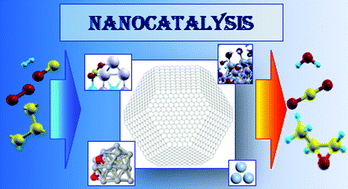
Catal. Sci. Technol., 2016,6, 6763-6765
https://doi.org/10.1039/C6CY90085B
Pd–In intermetallic alloy nanoparticles: highly selective ethane dehydrogenation catalysts
2 nm PdIn intermetallic alloy (cubic, CsCl type) nanoparticle catalyst was near 100% selective to ethane dehydrogenation at 600 °C (at 15% conversion) with a dehydrogenation TOR almost 10 times higher than that of monometallic Pd.

Catal. Sci. Technol., 2016,6, 6965-6976
https://doi.org/10.1039/C6CY00491A
Electrochemical behaviour of naked sub-nanometre sized copper clusters and effect of CO2
In size-controlled naked Cu5 and Cu20 nanoclusters the latter show anodic redox processes occurring at much lower potential with respect to Cu5, but the latter coordinate effectively CO2 and allow to reduce CO2 under cathodic conditions at lower overpotential.

Catal. Sci. Technol., 2016,6, 6977-6985
https://doi.org/10.1039/C6CY00942E
The effect of phosphorus on the catalytic performance of nickel oxide in ethane oxidative dehydrogenation
Adding P to NiO leads to a decrease of ethane conversion with an increase in ODH selectivity.
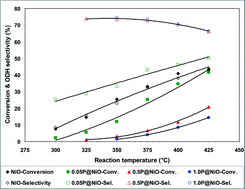
Catal. Sci. Technol., 2016,6, 6953-6964
https://doi.org/10.1039/C6CY00946H
In situ study of the electronic structure of atomic layer deposited oxide ultrathin films upon oxygen adsorption using ambient pressure XPS
APXPS was used to investigate the effect of oxygen adsorption on the band bending and electron affinity of ALD Al2O3, ZnO and TiO2 ultrathin films.

Catal. Sci. Technol., 2016,6, 6778-6783
https://doi.org/10.1039/C6CY00575F
Selective gas phase hydrogenation of nitroarenes over Mo2C-supported Au–Pd
The first reported synthesis of Au–Pd/Mo2C from colloidal nanoparticles with enhanced selective catalytic hydrogenation of functionalised nitroarenes.

Catal. Sci. Technol., 2016,6, 6932-6941
https://doi.org/10.1039/C6CY00514D
Steady-state reaction kinetics of CO oxidation catalyzed by uni-sized Pt30 clusters directly bound to Si surface
Catalytic CO oxidation driven by uni-sized Pt30 bound to a Si substrate, at the interface of which electrons are accumulated. The low-temperature and anti-CO-poisoning performance has been evidenced with continuous and simultaneous supply of CO and O2.
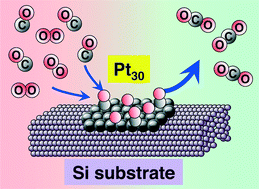
Catal. Sci. Technol., 2016,6, 6910-6915
https://doi.org/10.1039/C6CY00623J
A DFT study of molecular adsorption on Au–Rh nanoalloys
Density functional theory calculations are performed to investigate both mixing and adsorption properties of 38-atom and 79-atom Au–Rh nanoalloys at the nanoscale.

Catal. Sci. Technol., 2016,6, 6916-6931
https://doi.org/10.1039/C6CY01107A
Structural investigation of supported Cun clusters under vacuum and ambient air conditions using EXAFS spectroscopy
Structural analysis of deposited nanoclusters using extended X-ray absorption fine structure (EXAFS) spectroscopy.
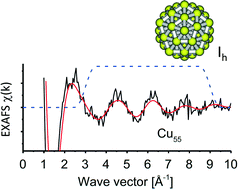
Catal. Sci. Technol., 2016,6, 6942-6952
https://doi.org/10.1039/C6CY00436A
Catalytic activity of Pt38 in the oxygen reduction reaction from first-principles simulations
Mechanism of OHads/Pt38 diffusion via transient hydronium species in first-principles molecular dynamics simulations.
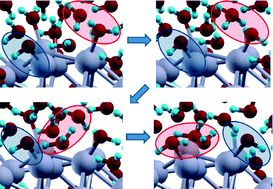
Catal. Sci. Technol., 2016,6, 6901-6909
https://doi.org/10.1039/C6CY00750C
Theoretical investigations of non-noble metal single-atom catalysis: Ni1/FeOx for CO oxidation
The single-atom catalyst Ni1/FeOx has a high activity for CO oxidation and the oxygen vacancy on the surface of this catalyst can be created at room temperature.
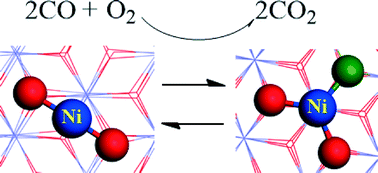
Catal. Sci. Technol., 2016,6, 6886-6892
https://doi.org/10.1039/C6CY00672H
H2/D2 exchange reaction on mono-disperse Pt clusters: enhanced activity from minute O2 concentrations
Hydrogen dissociation on mono-disperse platinum clusters is found to increase with minute amounts of oxygen in the gas stream.
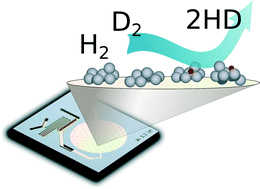
Catal. Sci. Technol., 2016,6, 6893-6900
https://doi.org/10.1039/C6CY00756B
Carbon supported Au–Pd core–shell nanoparticles for hydrogen production by alcohol electroreforming
Monodisperse faceted icosahedral Au–Pd core–shell nanocrystals of small size (<12 nm) supported on Vulcan XC-72 (Au–Pd/C) are employed in electroreforming for the cogeneration of hydrogen and valuable chemicals.
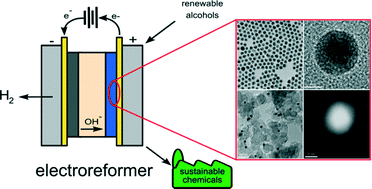
Catal. Sci. Technol., 2016,6, 6870-6878
https://doi.org/10.1039/C6CY00720A
A combined theoretical and experimental EXAFS study of the structure and dynamics of Au147 nanoparticles
We demonstrated the capability of combined EXAFS and DFT calculations for characterizing the structural and thermal properties of Au147 clusters.

Catal. Sci. Technol., 2016,6, 6879-6885
https://doi.org/10.1039/C6CY00559D
Understanding oxidative dehydrogenation of ethane on Co3O4 nanorods from density functional theory
Density functional theory calculations reveal the complete pathways of oxidative dehydrogenation of ethane to form ethene on the Co3O4(111) surface and the rate-determining step.

Catal. Sci. Technol., 2016,6, 6861-6869
https://doi.org/10.1039/C6CY00749J
Support effect for nanosized Au catalysts in hydrogen production from formic acid decomposition
Au catalysts with the same particle sizes demonstrate the following order of activity in formic acid decomposition: Au/Al2O3 > Au/ZrO2 ∼ Au/CeO2 > Au/La2O3 > Au/MgO.
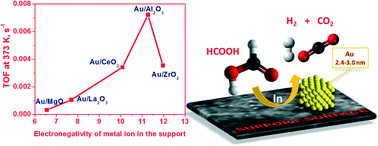
Catal. Sci. Technol., 2016,6, 6853-6860
https://doi.org/10.1039/C6CY00552G
Design and synthesis of model and practical palladium catalysts using atomic layer deposition
We investigated the “one-batch” synthesis of model and practical palladium catalysts using atomic layer deposition (ALD).

Catal. Sci. Technol., 2016,6, 6845-6852
https://doi.org/10.1039/C6CY00682E
Crotonaldehyde hydrogenation on platinum–titanium oxide and platinum–cerium oxide catalysts: selective C![[double bond, length as m-dash]](https://www.rsc.org/images/entities/char_e001.gif) O bond hydrogen requires platinum sites beyond the oxide–metal interface
O bond hydrogen requires platinum sites beyond the oxide–metal interface
We have investigated a series of Pt–TiO2 and Pt–CeO2 catalysts for crotonaldehyde hydrogenation with the goal of better understanding the kinetics of C![[double bond, length as m-dash]](https://www.rsc.org/images/entities/char_e001.gif) O bond hydrogenation.
O bond hydrogenation.
![Graphical abstract: Crotonaldehyde hydrogenation on platinum–titanium oxide and platinum–cerium oxide catalysts: selective C [[double bond, length as m-dash]] O bond hydrogen requires platinum sites beyond the oxide–metal interface](/en/Image/Get?imageInfo.ImageType=GA&imageInfo.ImageIdentifier.ManuscriptID=C6CY00858E&imageInfo.ImageIdentifier.Year=2016)
Catal. Sci. Technol., 2016,6, 6824-6835
https://doi.org/10.1039/C6CY00858E
Critical role of interfacial effects on the reactivity of semiconductor-cocatalyst junctions for photocatalytic oxygen evolution from water
Photocatalytic water splitting has the potential to provide a sustainable approach for storing the energy of solar photons in the form of chemical bonds.
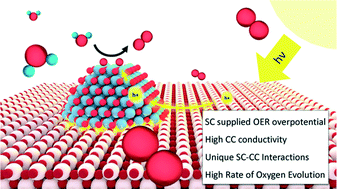
Catal. Sci. Technol., 2016,6, 6836-6844
https://doi.org/10.1039/C6CY00548A
Reactivity of diatomics and of ethylene on zeolite-supported 13-atom platinum nanoclusters
CO and NO react on hydrogen-covered 13-atom Pt clusters, O2 does not, and the hydrogenation of ethene shows structure sensitivity.

Catal. Sci. Technol., 2016,6, 6814-6823
https://doi.org/10.1039/C6CY00182C
Towards stable single-atom catalysts: strong binding of atomically dispersed transition metals on the surface of nanostructured ceria
Surface oxygen sites on CeO2 nanostructures are able to bind atoms of various transition metals strong enough to prevent their sintering. This finding opens a knowledge-driven way to prepare stable single-atom catalysts with maximum metal efficiency.

Catal. Sci. Technol., 2016,6, 6806-6813
https://doi.org/10.1039/C6CY00294C
The conversion of CO2 to methanol on orthorhombic β-Mo2C and Cu/β-Mo2C catalysts: mechanism for admetal induced change in the selectivity and activity
Cu clusters supported on β-Mo2C improve the selectivity towards methanol decreasing the amount of methane.
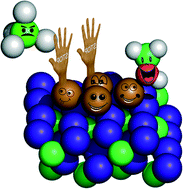
Catal. Sci. Technol., 2016,6, 6766-6777
https://doi.org/10.1039/C5CY02143J
Unusual behaviour of Au/ZnO catalysts in selective hydrogenation of butadiene due to the formation of a AuZn nanoalloy
The loss of activity observed when Au/ZnO was activated under H2 was explained by the formation of AuZn alloy.

Catal. Sci. Technol., 2016,6, 6794-6805
https://doi.org/10.1039/C5CY01664A
Gold assisted oxygen dissociation on a molybdenum-doped CaO(001) surface
Using density functional theory (DFT) calculations, we address the adsorption of O2 and the coadsorption of gold species and oxygen molecules on a Mo-doped CaO(001) surface with 1.25% impurity concentration.
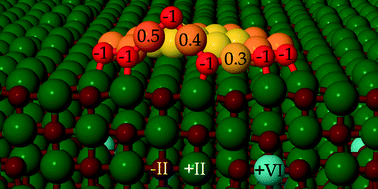
Catal. Sci. Technol., 2016,6, 6784-6793
https://doi.org/10.1039/C5CY01839K
About this collection
This themed issue showcases research in the fundamental understanding and technological applications of catalysis by nano-sized metal and metal-oxide clusters. The Guest Editors are Stefan Vajda (Argonne National Laboratory) and Alessandro Fortunelli (Italian National Research Council).